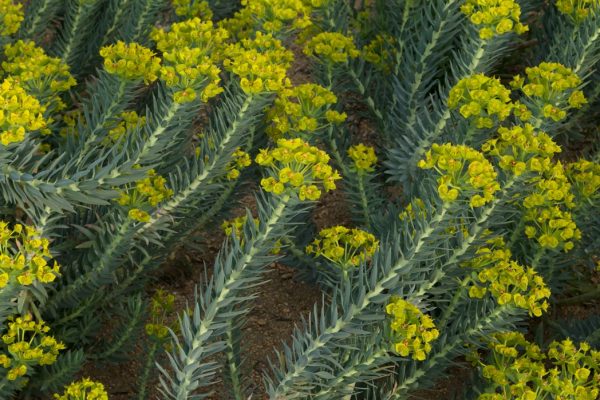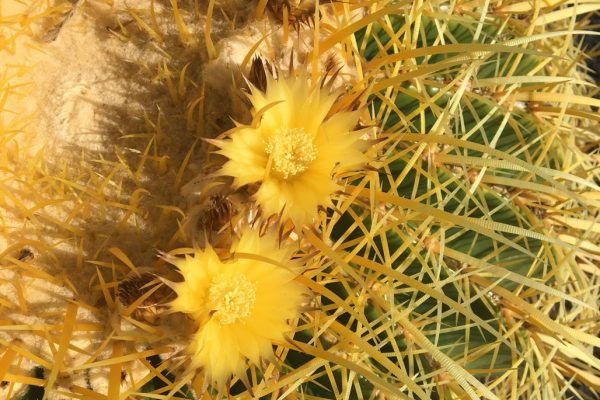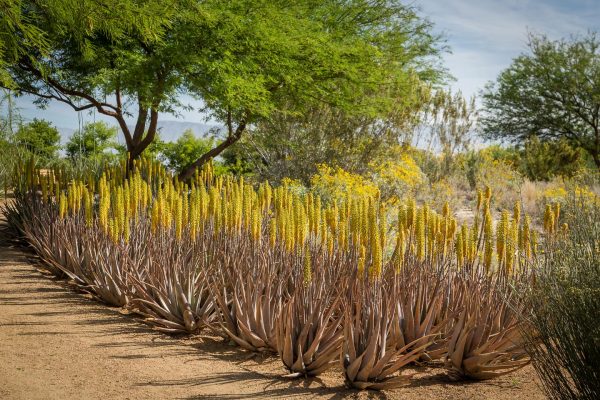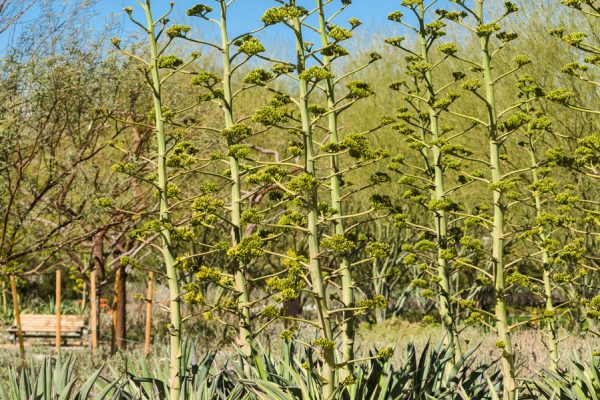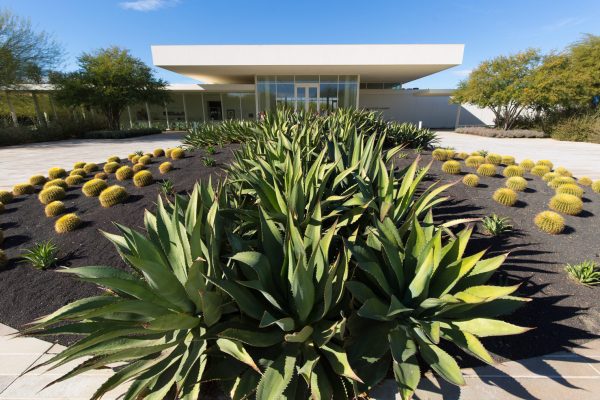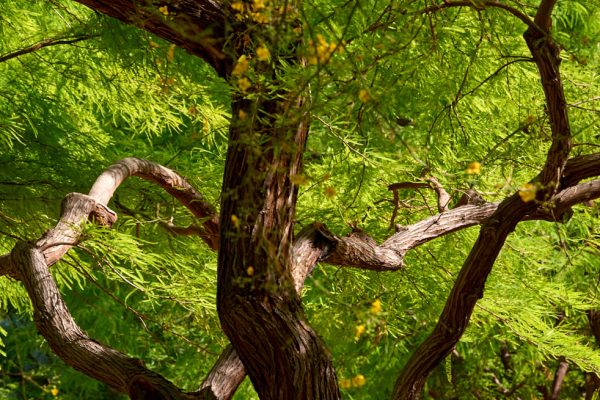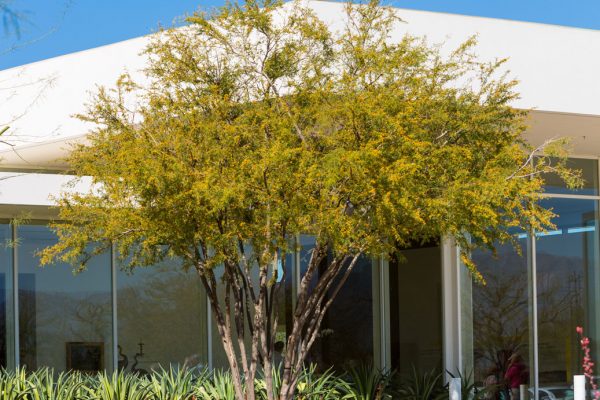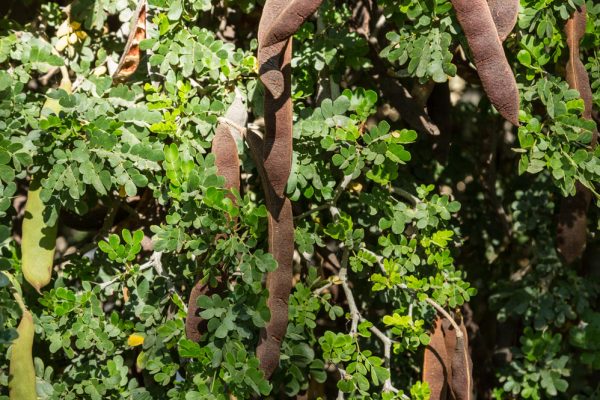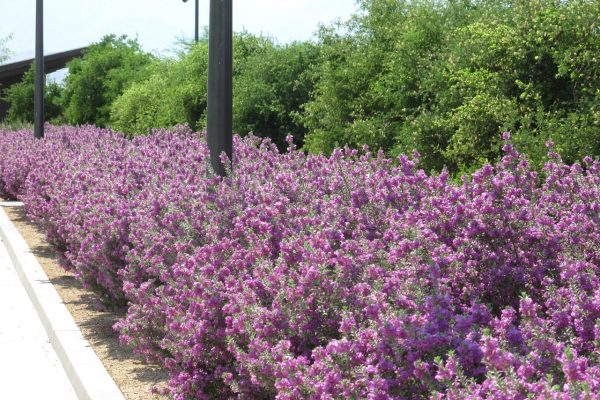
Leucophyllum is the genus for a group of hardy desert shrubs. Most people know it from the common name Texas Ranger or Texas Sage, though it is not a Salvia. Years of commercial cultivation has created a variety of sizes and colors that guarantee a visual variation for almost every desert garden. It blooms in ranges of deep purple to violet and periwinkle, and its fuzzy leaves range from green to silver-gray. Even its size can vary from large shrubs, reaching 6 feet, to smaller compact shrubs.
Sunnylands initially installed six specimens of Leucophyllum spp., but over the years, there have been a few species that triumphed in the gardens. They were the most pest resistant and stood out in color and form. We have reduced the original six to three highlighted species. They are distributed throughout the gardens and can be identified by leaf and/or bloom. The three are, by common name: Green Cloud, Heavenly Cloud, and Sierra Bouquet. They are grouped together here under their genus Leucophyllum, so that their visual features are easy to compare when standing in the gardens.
GREEN CLOUD (Leucophyllum frutescens ‘Green Cloud’)
Green foliage with purple flowers
HEAVENLY CLOUD (Leucophyllum x. ‘Heavenly Cloud’)
Green foliage with bright purple flowers
SIERRA BOUQUET (Leucophyllum pruinosum ‘Sierra Bouquet’)
Gray foliage with periwinkle flowers
The steel, blue-green Gopher Plant is unique in the gardens. It grows upward on stalks with leaves equally distributed down its stem. When planted among smooth agaves and aloes, it adds interest and contrast to their form. It only requires occasional water and can handle poor and/or rocky soil.
When Gopher Plant blooms, it forms a cluster of flowers in chartreuse bracts (modified leaves). The flower shape is reminiscent of a view through a kaleidoscope in its round, symmetrical pattern. This bee favorite is stunning when in full bloom, and when the blooms dry out, they continue to provide visual interest. Stems can be cut all the way down to the plant base after it blooms, where new stems will regrow.
This Euphorbia is native to southern Asia and southwestern Europe.

The Golden Barrel cactus forms dense wooly caps, from which it can grow crowns of yellow, cup-shaped blooms in spring and summer. These cactuses, like agaves and many other succulents, also produce clones and can create a colony of barrels all stemming from one parental plant.
At Sunnylands, this showstopper is planted in the scoria-mulched beds under the Palo Breas, adjacent the Center. Planted alone in rows, it draws visitors with cameras trying to capture unique views that emerge below the Palo Brea trees. In other parts of the gardens, it shares the spotlight with the San Pedro cactus.
Mary Irish, horticultural consultant on the project, describes these spotlights: “San Pedro cactus and Golden Barrel cactus are set like twin jewels on the dark base. This dramatic presentation is one of the artistic gems visitors find while wandering through the gardens.”
At sunset, the bright green flesh and yellow spines create a glowing effect that looks as if they radiate light.
This cactus, included on the Convention for International Trade of Endangered Species (CITES) list, is endangered in the wild. Transport across international lines is restricted as the demand for certain desirable species often results in their depletion at their home of origin, as they are poached and transported to private collections around the world. Now heavily commercially cultivated, they are more available, but as the plants grow to larger sizes, their price point increases, leaving older, wild specimens in danger of being poached.
Groupings of Medicinal Aloes completely fill their planting beds throughout the gardens as they rapidly produce pups at their base. Growing to heights of 3 feet, their formal structure is effective as both an eye-catching backdrop for some smaller specimens and a front-and-center showstopper along other garden paths.
Medicinal Aloe is particularly striking from January through spring when it blooms in mass. Tall bayonets of yellow flowers create a frenzy of pollinator competition as bees and hummingbirds dodge each other to visit each bloom. The bloom stalks remain in place until all have completed their full cycle through seed setting—communicating that while the Sunnylands garden is an aesthetic garden, laid out with an artistic intent, it also embraces the natural process that allows each plant to complete its cycle.
The origin of Medicinal Aloe is the Arabian Peninsula, but today it is widely propagated around the world for both its aesthetic and medical qualities.
Some Smooth Agave began blooming within a season of their planting. In order to ensure that the Center & Gardens would look established on opening day in 2012, some more mature specimens were used. For the agaves, this meant they would be closer to blooming. The first specimen began to bloom in 2013 and additional ones have continued blooming each year since. This has offered visitors the opportunity to see blooms each season, which is great for the experience but results in the necessity of replacement of individual plants.
The Smooth Agave sends up a thick, branching stalk that blooms bright yellow and then forms bulbils (small, fully formed plants), which can be replanted. Smooth Agave does not exist in the wild but is common in cultivation and its offsets form early, so replanting is not difficult.
It has been found to be cold sensitive and die off of lower leaves immediately after a frost is possible.

In front of the Center, in the middle of the motor court, is a medallion-shaped bed where specimens of Cowhorn Agave are arranged among Golden Barrel cactus in a black scoria (lava stone) mulch. The margins of the Cowhorn’s leaves display reddish-brown teeth in a dimorphic (two-style) growth pattern. The teeth are both straight and curved, which results in a “snaggle-toothed” appearance. This is a contrast to some other agaves, which have a somewhat more uniform margin. Cowhorn is also found along the entry drive near the Bob Hope gate, but safe, close-up viewing is best done at the motor court.
This native of Mexico grows wild within an elevation range of 3,000 to 6,000 feet. Cowhorn Agave has not yet bloomed at Sunnylands. It will bloom only once, at end of life—usually between 12 to 18 years. The spike can reach over 20 feet, displaying greenish-yellow flowers.
This species does very well on the desert floor. Though it is more likely to be harmed by frost, it can be light sensitive during high-summer heat.

The gardens are filled with a variety of thorn-less hybrid mesquites. In fact, other than the four Sweet Acacia trees that frame the motor circle in front of the Center, mesquites are the only brown-barked trees in the garden. Their bark colors range from a gray-brown to a deep red-brown and they display a variety of smooth and rough textures.
Mesquites grow naturally as multi-branching trees, which allows them to bend with the strong desert winds. In most of the garden, you will see this multi-trunk growth pattern, but for accessibility in the parking lot and along some paths, they are trained to grow in a single-trunk standard. Whenever possible, natural growth patterns should be encouraged.
As a tribute to Leonore Annenberg, all the trees selected for the Center & Gardens have yellow blooms, one of her favorite colors, and the mesquites are no exception. In the spring, they form dense groupings of yellow tubular flower clusters.
Like many native desert trees, mesquites are legumes, which nourish the desert floor by dropping nitrogen-rich leaves, seedpods, and branches. These fertile grounds offer opportunities for young, fragile plants to get an easier start, but it also means that they require more cleanup.
Their sweet seedpods have been a food staple for humans and native wildlife alike.
There are four Sweet Acacia trees at the Center & Gardens. They are planted in front of the Center, creating four corners of the entry around the motor circle. This design element is a reference to the historic estate, where grapefruit trees in lava stone planters anchor the home’s motor circle.
These trees are most popular during their spring and fall bloom when their flowers fill the air with a sweet aroma. They have been cultivated around the world, but particularly in Cannes and other parts of southern France where their flower’s essential oil is harvested for use in perfumes.
The beauty of their scent is not lost on the pollinators, as this is a bee favorite.
Texas Ebony is easy to spot as it creates the tall hedge that surrounds the Center & Gardens. Its zigzagging branch structure is one of its most interesting features and makes it uniquely striking. Planting locations should be carefully selected as its branches are covered in long, rigid thorns, making it virtually impossible to infiltrate.
Like many desert trees, its leaves are small and glossy, which assist it in reducing water loss through transpiration. In spring, it fills with fragrant, light cream-colored flowers. The woody seedpods that follow the blooms are large and can remain on the tree for up to a year. When mature, the pods twist open to scatter their seeds. Though the pods and seeds can create litter, it is deciduous (leaves shed just once a year) in most places so leaf litter is of less concern.

